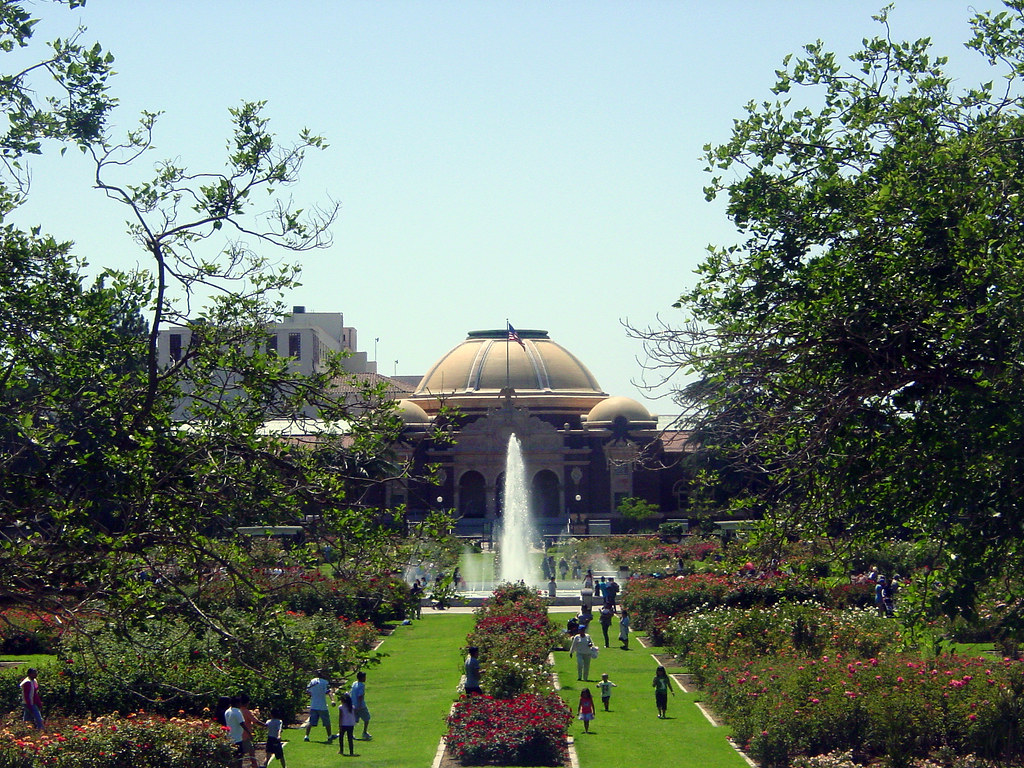
In order to protect the garden from such threats, it was added to the National Register of Historic Places in 1991. The Los Angeles Times ran an editorial opposing the plan: "There are times when the leaders of Los Angeles seem perversely intent on living up to the image that many outsiders have of them-insensitive and uncouth rabbits who would, say, dig up a garden to put in a parking lot." The garden had also been threatened by an earlier proposal by the Los Angeles Raiders football team to convert the garden into a practice field for the team. In 1986, plans to dig up the garden to build an underground parking garage led to protests in the media. Threat to the Rose Garden and historic designation The garden is located adjacent to the University of Southern California campus, the Natural History Museum of Los Angeles County, and the California Science Center. The garden also has four gazebos, several statues, and a central fountain. The garden is reportedly visited by more than a million people a year and is a popular location for weddings, reflection, and other events. The All-America Rose Selection, a rose growers organization, began donating its Rose of the Year to the garden in 1940. By the mid-1980s, the garden had more than 20,000 rose bushes and more than 200 varieties of roses. In the 1950s, the annual pruning demonstration drew thousands of rose enthusiasts to the park. The sculptor explained her intent with the statues this way: "In conceiving and executing these four figures dedicated to womanhood and motherhood, I have had in mind that men for centuries have erected statues symbolizing bravery-these symbolize love, life and joy." Popularity of the Rose Garden

The statues were titled "Nymph Finding Pipes of Pan," "The Blessing" (dedicated to the mothers of the world), "The Start" (awarded first prize by the Danish Academy of Fine Arts), and "Terpsichore" (or "Melody of Life"). In 1936, four large marble statues by Danish sculptor Thyra Boldsen were installed on pedestals at the four corners of the garden. When the garden was announced, the Los Angeles Times applauded the project: "No more fitting tribute could be paid to the spirit of Southern California than to erect in the center of her largest city the greatest rose garden in the world." During the Great Depression, the lack of funding threatened the closure of the rose garden, then described as "the largest rose garden in the world." Boldsen statues The rose garden area was then used for horse, camel, dog, and later automobile racing it also reportedly housed the city's longest bar and "one of its most stylish brothels." In 1914, the city announced plans to construct a wildflower garden at the park, but the rose garden was not built until 1927 with the planting of 15,000 bushes of more than 100 varieties. It was added to the National Register of Historic Places in 1991.Įstablishment of the rose garden įrom 1871 to 1911, the site of the rose garden was part of the city's Agricultural Park.

/KMD11ExpPkRoseGarden_0047lg-5988a6e20d327a00114062b3.jpg)
It has been called "one of the city's best-kept secrets". The Exposition Park Rose Garden is a historic 7-acre (28,000 m 2) sunken garden located in Exposition Park in Los Angeles, California.


 0 kommentar(er)
0 kommentar(er)
